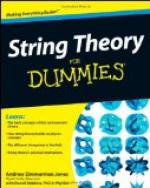|
This section contains 2,266 words (approx. 8 pages at 300 words per page) |

|
Physicists believe there to be four fundamental forces. Three of these—the electromagnetic, the strong force, and the weak force—are amalgamated in the standard model of elementary particle physics, a family of quantum field theories that has enjoyed stupendous empirical success. Gravity, the fourth and feeblest fundamental force, is the subject of a stupendously successful nonquantum field theory, Einstein's general theory of relativity (GTR). Desiring to fit all of fundamental theoretical physics into a quantum mechanical framework, and suspecting that GTR would break down at tiny ("Planck scale," i.e., 10−33 cm) distances where quantum effects become significant, physicists have been searching for a quantum theory of gravity since the 1930s. In the last quarter of the twentieth century, string theory became the predominant approach to quantizing gravity, as well as to forging a unified picture of the four fundamental forces. A minority approach to quantizing...
|
This section contains 2,266 words (approx. 8 pages at 300 words per page) |

|


